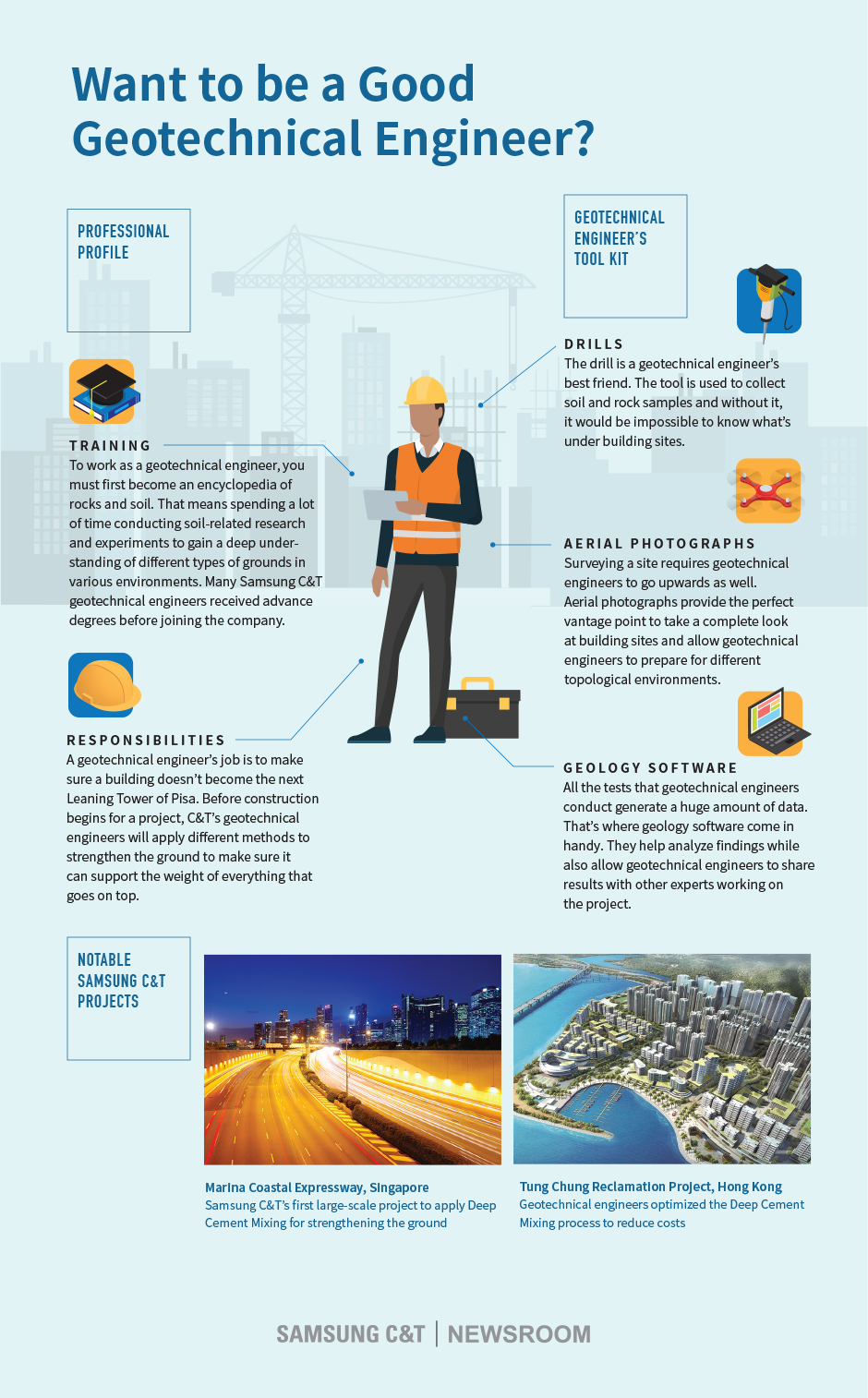A Biased View of Geotheta
Table of ContentsExamine This Report on GeothetaThe Basic Principles Of Geotheta The Of GeothetaSee This Report on GeothetaThe Best Guide To Geotheta

They conduct site examinations, gather samples, carry out laboratory tests, and evaluate information to assess the viability of the ground for construction jobs - Consulting Engineers. Based upon their searchings for, geotechnical designers offer recommendations for foundation style, incline security, preserving frameworks, and mitigation of geotechnical risks. They collaborate with other professionals, such as architects, structural engineers, and building groups, to make sure that geotechnical factors to consider are incorporated into the general task layout and implementation
By analyzing the behavior and properties of soil and rock, they can identify possible geotechnical dangers such as landslides, soil settlement, or incline instability. Their experience assists prevent failings or mishaps that might endanger lives and home. Below are some in-depth responsibilities and responsibilities of a geotechnical designer: Site Examination: Geotechnical designers conduct site examinations to collect information on subsurface problems.
They interpret the data to comprehend the properties and habits of the dirt and rock, including their strength, permeability, compaction characteristics, and groundwater problems. Geotechnical Analysis and Style: Geotechnical engineers assess the data collected during website examinations to evaluate the stability and viability of the website for construction jobs. They perform geotechnical estimations and modeling to assess elements such as bearing capability, settlement, incline stability, lateral earth pressures, and groundwater circulation.
Some Ideas on Geotheta You Need To Know
Foundation Style: Geotechnical designers play a vital duty in designing structures that can safely sustain the designated structure. They evaluate the soil problems and lots demands to establish the ideal foundation type, such as superficial foundations (e.g., footings), deep foundations (e.g (https://yoomark.com/content/httpsgeothetacom)., heaps), or specialized strategies like soil improvement. They consider variables such as negotiation limitations, birthing capability, and soil-structure interaction to develop ideal foundation layouts
They examine construction strategies, display site activities, and conduct field inspections to validate that the layout recommendations are adhered to. If unanticipated geotechnical issues occur, they examine the situation and provide suggestions for removal or changes to the layout. Threat Analysis and Reduction: Geotechnical designers analyze geotechnical hazards and threats connected with the task site, such as landslides, liquefaction, or dirt disintegration.

Cooperation and Communication: Geotechnical designers function closely with other professionals associated with a job, such as engineers, structural designers, and building and construction teams. Efficient communication and collaboration are vital to integrate geotechnical considerations right into the general project design and construction procedure. Geotechnical engineers provide technological experience, solution inquiries, and ensure that geotechnical needs are fulfilled.
Unknown Facts About Geotheta
Here are some kinds of geotechnical designers: Foundation Designer: Foundation designers concentrate on making and evaluating foundations for frameworks. They assess the soil problems, tons needs, and site features to identify the most suitable structure type and design, such as shallow foundations, deep foundations, or specialized techniques like heap foundations.
They assess the factors affecting slope stability, such as dirt residential properties, groundwater conditions, and slope geometry, and establish techniques to prevent incline failures and reduce dangers. Quake Engineer: Quake designers specialize in examining and designing frameworks to stand up to seismic pressures. They examine the seismic threat of a website, examine dirt liquefaction capacity, and establish seismic layout criteria to guarantee the security and strength of structures throughout quakes.
They carry out field testing, collect samples, and examine the accumulated information to define the soil homes, geologic formations, and groundwater problems at a website. Geotechnical Instrumentation Engineer: Geotechnical instrumentation engineers focus on tracking and determining the actions of soil, rock, and frameworks. They set up and keep instrumentation systems that keep an eye on variables such as dirt negotiation, groundwater levels, slope activities, and architectural displacements to evaluate efficiency and offer early warnings of possible problems.
The Greatest Guide To Geotheta
They carry out tests such as triaxial examinations, debt consolidation tests, straight shear tests, and leaks in the structure examinations to collect data for geotechnical evaluation and style. Geosynthetics Designer: Geosynthetics designers concentrate on the style and application of geosynthetic materials, such as geotextiles, geogrids, and geomembranes. They make use of these products to improve dirt security, strengthen slopes, provide drain options, and control erosion.
They have a tendency to be investigatory individuals, which implies they're intellectual, introspective, and curious. They are interested, methodical, logical, logical, and logical. Some of them are additionally social, meaning they're kind, generous, cooperative, patient, caring, useful, empathetic, sensible, and friendly - Engineer of Record.
In the office setting, geotechnical designers utilize specialized software devices to do calculations, create layouts, and evaluate data. They prepare records, review task specs, interact with clients and employee, and coordinate project activities. The workplace setting supplies a conducive setting for research, analysis, and collaboration with various other experts involved in the task.
The Best Guide To Geotheta
They often check out project sites to perform site investigations, assess geotechnical conditions, and collect information for analysis. These sees involve traveling to different places, often in remote or challenging visit terrains. Geotechnical engineers may do dirt tasting, conduct examinations, and monitor building and construction activities to make sure that the geotechnical facets of the project are being applied properly.
Geotechnical designers likewise operate in specialized geotechnical research laboratories. In these centers, they perform experiments, perform tests on dirt and rock examples, and evaluate the engineering residential or commercial properties of the materials. Geotechnical research laboratory designers function extensively in these atmospheres, managing testing equipment, operating instruments, and taping information. They team up with other research laboratory team to guarantee precise and trustworthy screening results.